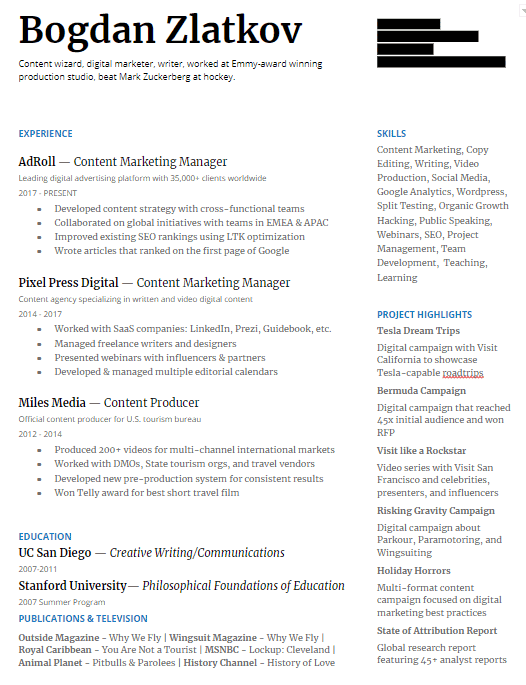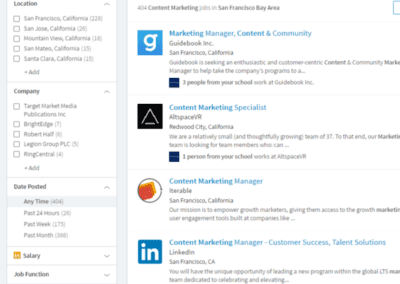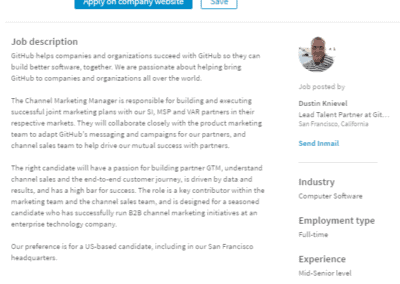How to Decipher Job Descriptions
It may not be obvious, but a lot of people go about applying to jobs in the wrong order. They decide what they are (i.e. a programmer, a writer, a lab tech) and then start building their resume without even looking at what jobs they will be applying for. Then they try to fit the job description to their pre-made resume.
The most effective way to start building your resume is to first search for jobs. When I was looking for content marketing jobs I had a very vague idea of what that position was anymore. That’s because job requirements are always changing and, if you’ve been out of the job market for a while, chances are you have an outdated understanding of what’s now required. So the first thing is to look up your given subject and see what’s out there and what’s in demand.
Here’s what my search looked like:
Here’s how to decipher what you see:
- Job Description: This is mostly a useless section. Most companies use this section of a job posting to hype themselves, hype the position, and write generic things about “culture fit.” I don’t even read section this anymore.
- Responsibilities: This is the most important section to look at. This is really what you’ll be doing on the job. You want to be able to do at least 70% of the things listed on here. If there are some things you can’t do or haven’t done, that’s okay, that’s called “room for growth.” We’ll also be using this section to create an amazing set of resumes and cover letters later on.
- Requirements: This section is just a filter and should be used as one. Employers like to exaggerate these qualifications because they think it will get them better candidates. I use these requirements very loosely. If it says “minimum 8 years experience…” and I only have 3 years experience then it’s probably not a good fit and they want someone more senior level. If it says “minimum 4 years experience…” and I only have 3 years, then I’ll apply anyway. Use this as a very rough filter of what they want.
As you look through different jobs you're interested, you'll probably notice that a lot of them are similar, but not quite identical. This is one of the main reasons that applying to jobs is such a pain.
When I was applying to jobs I would spend hours honing my resume for a job. After applying to that job, I would go back on the search only to find out that the next job I wanted to apply for required slightly different skills and experience.
Luckily, I had the right experience for this next job, all I had to do was change my resume a bit...
2 hours of fiddling with Word later, I had my next resume.
This process slowly and painfully started draining all my energy. I found myself no longer putting my full effort into my resume and simply blasting the same resume to all the jobs I could find.
Unsurprisingly, I got almost zero responses to my generic resume.
That's when I decided I needed to create a resume that would be modular, meaning I could swap out sections and bullet points to make my resume tailored to the jobs I was applying to.
After several rounds of trial and error I created the perfectly modular resume which you can see below:

This resume template ended up earning me 35+ interviews and landed me my job at LinkedIn. (You can this exact same resume template, plus 3 more in the Accelerated Resume Course).
If you're serious about getting a job I highly recommend taking one of the career courses below. Each course summarizes years of best practices I've learned from professional recruiters and working at LinkedIn.
Read more resume and interview best practices on The GHYC Blog.
Text Sample Box
Text Sample Box
Text Sample Box
More from the blog:

Best Resume Builders of 2023 (Pros & Cons + Prices)
Modern resume builders use AI, ATS-friendly templates, and active recommendations to help you build your perfect resume faster than ever before. In this post we’ve rounded up the 5 best resume builders of 2023.
How to Beat the ATS in 25 Minutes | The Ultimate Guide
In this guide I’ll show you how to beat the ats (applicant tracking system), plus I’ll give you 2 ATS-friendly resume templates and a free tool to test if your resume is ATS-friendly.
Accelerate your career with a course!
Tired of waiting to hear back from hiring managers? Speed up your job search with one of our accelerated courses. Learn how to optimize your resume, improve your LinkedIn, and nail your interviews to get hired within weeks!
Bogdan Zlatkov is the Founder of GHYC and author of "The Ultimate Guide to Job Hunting", ranked #1 on Google. He has been featured in the Wall Street Journal, Fast Company, HR Dive, and more. At GHYC, Bogdan creates job search courses & tools by working with award-winning career coaches, best-selling authors, and Forbes-Council members. Prior to GHYC, Bogdan led the content programs at LinkedIn Learning.


